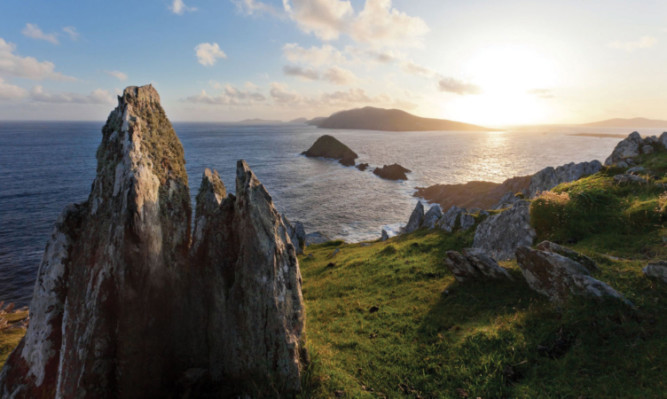
The Irish coastal route is rugged and beautiful in equal measure.
Forget Route 66 the Irish coastal roads along the Wild Atlantic Way make for a world-class road trip.
I rest on my kayak paddle and gaze at the horizon as a golden hue from the setting sun illuminates the pale waters at Killary fjord.
Sandstone mountains, serried masses crowding the skyline, are covered in a thick coating of verdant grass testament to more than 200 days of rainfall a year.
The area is known as Connemara, an austerely dramatic region characterised by windswept and relatively inaccessible upperlands, mountain lakes and rivers.
Its most populous residents are black-faced scraggly sheep who roam unfettered across miles of common land.
Connemara forms part of the Wild Atlantic Way, a driving route running from Donegal in the north west of Ireland to Cork in the south west, covering 1,500 miles.
Milestones include the burial ground of celebrated poet WB Yeats and the home of actor Peter O’Toole, as well as sombre reminders of the death toll Ireland suffered during the famine of 1846.
I stop at a commemorative stone memorial overlooking a mountain lake. An artificial flower has been placed on top. Of course, much time has passed and the area now prospers through the tourist trade.
Great pride has been taken in the regeneration of postcard pretty Mulranny, a former one-street stop on the railway from Westport in Mayo, which dwindled into relative obscurity for much of the 20th Century.
I pass an old lady on the road, standing beside a sign proclaiming “Guinness for Strength”. She rests on two sticks, grey wispy hair peeking out from under the scarf wrapped around her head.
Humans have shaped this landscape for 5,700 years; at the Ceide Fields in Co Mayo, I receive a fascinating insight into what is reputedly the oldest farm in the world.
Deep beneath peaty soil on a piece of land overlooking the Atlantic, archaeologists have discovered miles of neolithic plots marked by long regular walls of stones.
None are too large to lift by hand, some strewn on the ground by the accumulation of years and earth. One is a lopsided enclosure used to pen animals, my guide tells me.
More evidence of the tree of life confronts me at Glencolmcille Folk Village, which features recreated cottages from the 18th, 19th and early 20th Centuries.
The tradition of large families produced overcrowding, and I shudder when I see awkward wooden seats where people once slept upright, due to lack of space.
It’s a stark contrast to the big houses, once owned by wealthy pro-establishment merchants or clergy, which dot the touring route.
The most splendid example I visit is Rathmullan House, near the northern tip of Ireland, surrounded by gardens scented by roses. Originally the home of an Anglican bishop, it became the country estate of Belfast banking family the Batts.
Each part of the hotel reflects the pursuits of landed gentlemen, including a library of worthy tomes, but most remarkable of all is the Raja Room, inspired by colonial India.
Russet cushions are embroidered with elephants, and the architecture is more reminiscent of the Taj Mahal than Victorian or wartime Britain.
From the grounds, there is easy access to the wide open beach, part of a network extending for miles along the Wild Atlantic Way. I discover this area is famous for horse riding.
As my cream and brown steed Murphy trots bumpily downhill from laneway to pristine sand, I sit back, as my guide instructs, like I’m in an armchair.
I can see the excited glint in the eye of Midnight, the horse leading our little group, as she anticipates a brisk trot though Atlantic surf near Dunfanaghy.
I try ineffectually to dissuade Murphy from nibbling marram grass on dunes surrounding the strand, but on reflection, I may as well not have been there.
The horses follow each other unquestioningly, tussling only over the water bucket at the end.
I’m immeasurably more comfortable with an electric bicycle, the reassuring push the battery gives me up the steep hills surrounding Downings in Rosapenna in Donegal, is a welcome, if guilty, fillip.
Adopting a conventional hybrid, on Mayo’s Greenway, I follow the route of an old railway track close to a lake shore, densely-vegetated mountains all around. Two-wheeled traffic is heavy, but the route is mainly picturesque.
The poster girl for scenery, however, remains the mountains around Killary in Connemara. I wade through tussocky grass well over my knees. Each step into an unknown warren of holes as I struggle to the top of one ridge.
My reward is the stunning views towards the fjord and beyond. When the rest of Ireland was originally planted by settlers from Britain, much of the indigenous population was forcibly transferred to this province, Connaught.
The choice for resisting Irish became “To Hell or Connaught”. As I stare dreamily at mountains meeting water, I realise I’m in my very own heaven.
Michael was a guest of Tourism Ireland. Ireland’s Wild Atlantic Way is the longest defined coastal touring route in the world. Out at the very edge of Europe, the Wild Atlantic Way stretches for 1,500 miles along Ireland’s western seaboard. From Malin Head in Co. Donegal to Kinsale in Co. Cork, through regions like Connemara, Galway Bay and Kerry.

Enjoy the convenience of having The Sunday Post delivered as a digital ePaper straight to your smartphone, tablet or computer.
Subscribe for only £5.49 a month and enjoy all the benefits of the printed paper as a digital replica.
Subscribe